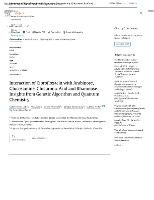Resumen
A theoretical study of the ciprofloxacin interactions with glucuronic acid, arabinose, glucosamine, and rhamnose is presented. The most stable complexes were obtained through genetic algorithms starting from the neutral and zwitterion species of ciprofloxacin. The energy at the semiempirical level PM7 of the optimal structures of the complexes was the genetic algorithm‘s fitness function. The resulting complexes’ geometry was optimized at M062X−D3/6-311++G** level of theory, and non-covalent interactions were assessed through the reduced density gradient and quantum theory of atoms in molecules. The results show that the zwitterion species of ciprofloxacin favorably complex carbohydrates and can induce proton exchange between them. The molecular complexes from proton exchange are the most stable, followed by the complexes formed by the contact of the zwitterion species and the carbohydrate. The complexes formed by both neutral species were the least stable. The medium strength and strong (assisted by charge) hydrogen bonds, the XH⋅⋅⋅π and lone-pair⋅⋅π interactions, were mainly present in the complexes. Proton exchange processes strengthen the interactions mentioned above. © 2022 Wiley-VCH GmbH














